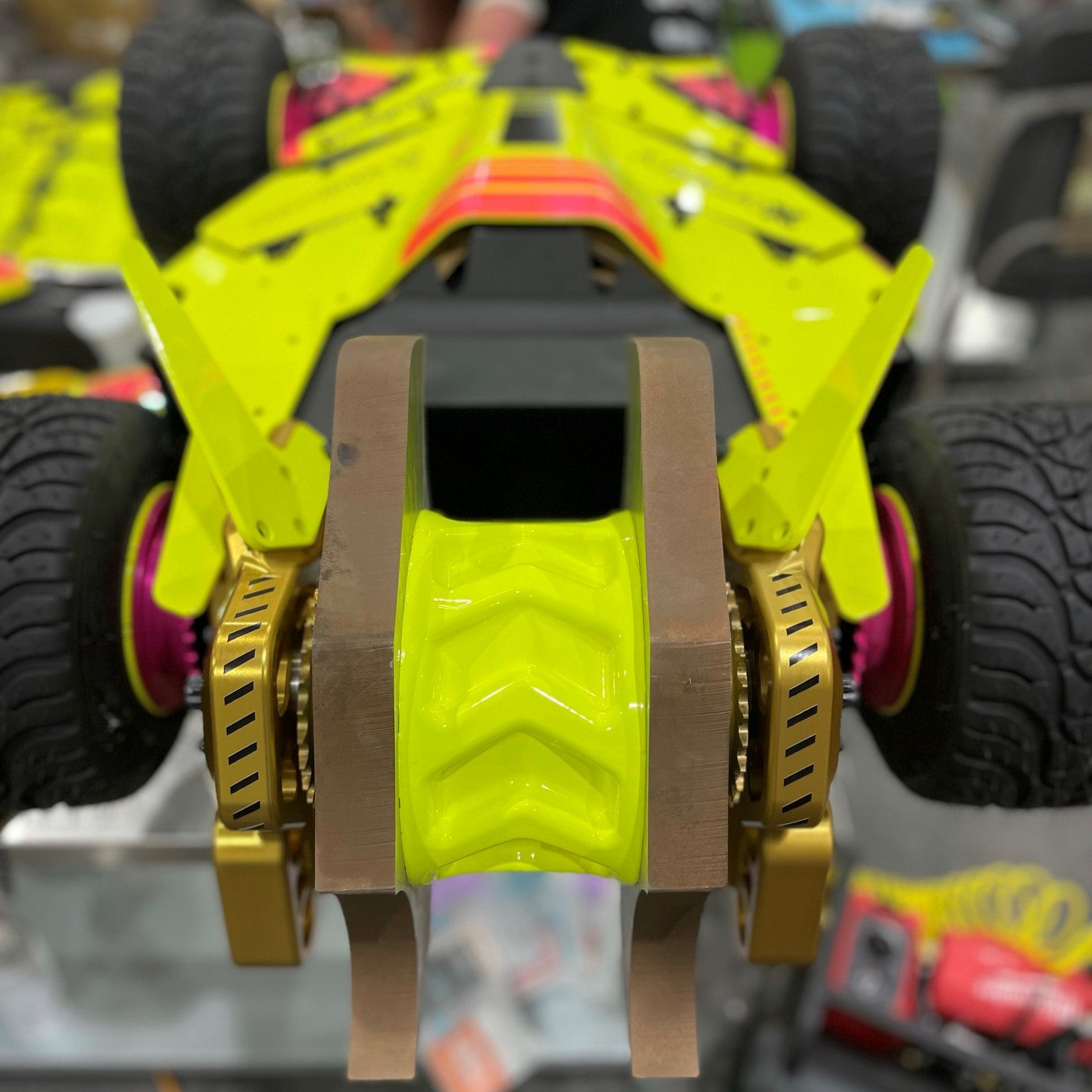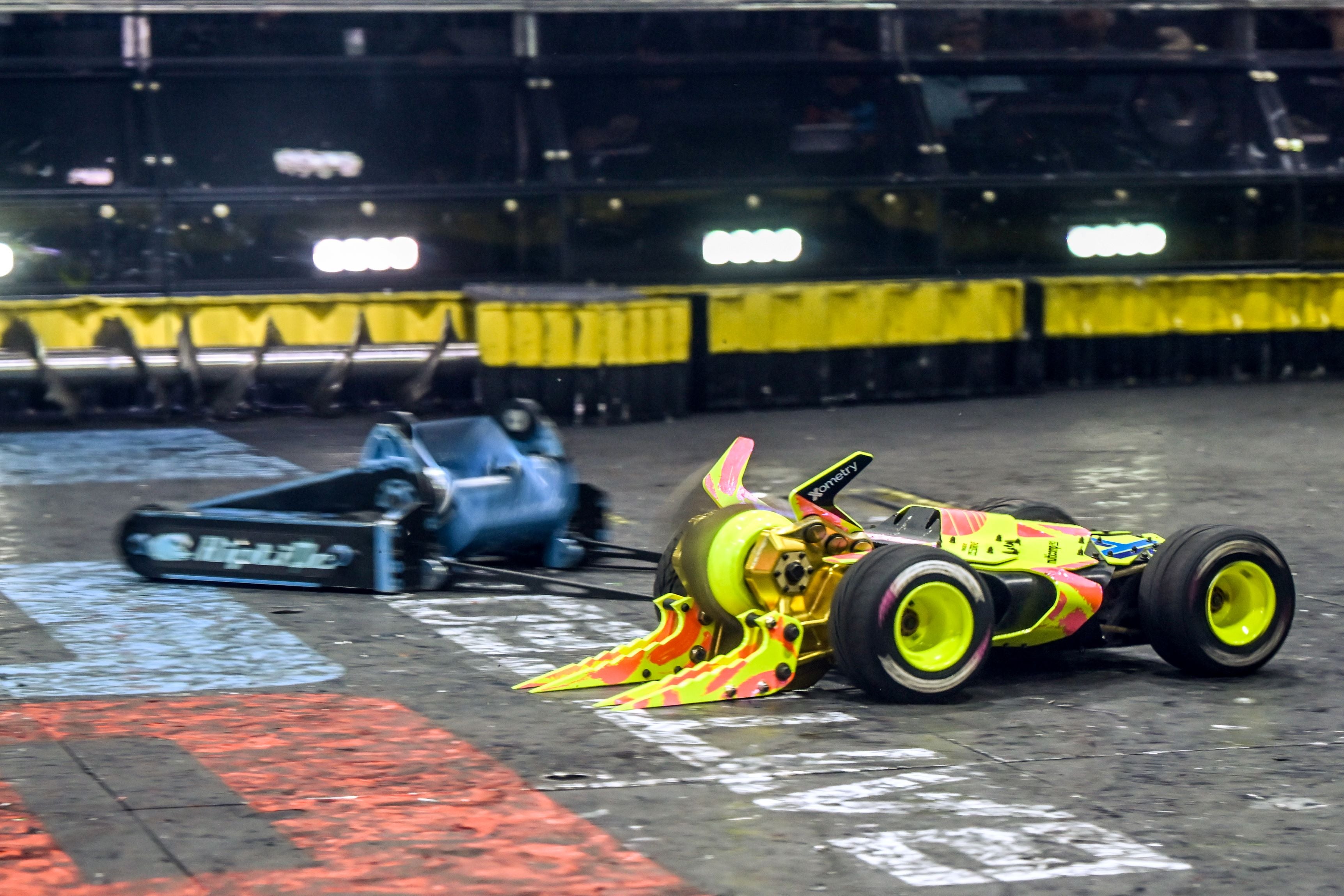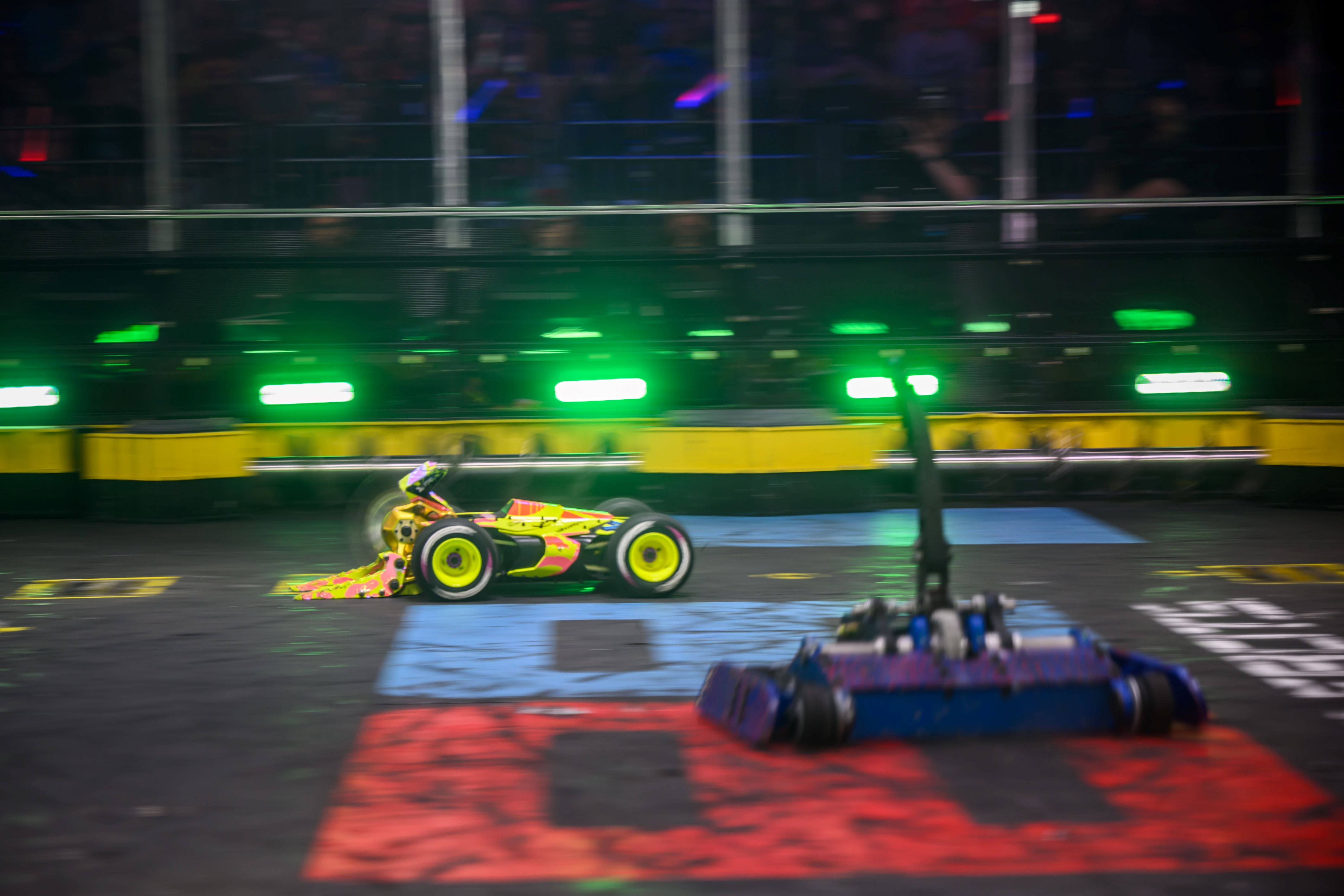HyperShock has run a drum-with-disks, or ‘drisk’ since Season 1 in 2015. In Season 4, we added a single disk weapon configuration to more safely fight horizontals. Our concern had been the thin (1 inch) disks would not survive a weapon to weapon impact with the likes of Tombstone. We make our disks out of S7 tool steel and harden them to 57 Rockwell C [https://en.wikipedia.org/wiki/Rockwell_scale]. We like running a drisk because it gives us some of the advantages of both a drum and a disk. From drums, we gain the wide attack angle and the MOI efficiency (explained later). From disks, we see advantages in manufacturing part efficiency and effective weapon reach. The downsides to a drisk are mostly shared with many drums because it ends up a multi-part assembly. We also have spend a lot of design time on lateral retention features since our weapons aren’t full width.

[Season 2 and 4 weapons]
We revamped the weapon design in Season 3 as part of an overall push to be more aggressive. We bumped up the tip diameter from 12” to 14” to improve our weapon reach beyond the front armor, also theoretically improving the overall MOI efficiency (more on this later). The new design would also move the vulnerable aluminum hub and the weapon belts deeper between the disks, reducing the risk of losing weapon drive mid-match. Lastly, We opted for a more robust single-piece weapon hub over the previous tube-with-end-caps construction we’d seen failures with before.

[Season 4 disks coming back from heat treat (hardening)]
The actual shape of the disks remained an undefined spline until Will was harassed into locking it in CAD this past year. We’d sat around before Season 3 playing with tooth geometry until we had something that looked cool and “right”. There wasn’t really any hard engineering that went into the curvy shape or the rake angle of the tooth, but we intuited that a sharper & scarier looking tooth profile would incur a more “slicing & dicing” kind of damage than the blunt force trauma so many other teams have opted for. We also knew it needed to be a durable shape with as much material behind the tooth as possible to prevent breakage during large hits. However, we sacrificed some MOI efficiency in favor of our exaggerated tooth design because A) it has less material for horizontal spinners to catch between teeth, and B) it looks cooler.
Now it’s time for a brief interlude to discuss MOI, or Moment Of Inertia. I’ll do my best to channel the spirit of Technical T-Rex: Explain the basics without lying too much, making it impossible to understand, or revealing how little I actually understand the subject. In caveman terms, MOI is how much “oomph” a spinning thing has. Specifically, the Moment Of Inertia of an object is its resistance to change speed as it spins about an axis. You can think of it as the “follow through” of a weapon. Two weapons could weigh the same and have the same tip diameter but have vastly different MOI purely based on the shape. For example: a ring-shaped disk and a rectangular bar could have the same mass and spin the same speed, but the ring-shaped disk would hit harder because it has more MOI. MO-why? Because the material in the spinning mass is distributed as far away from the axis of rotation as possible, and this increases the MOI. This phenomenon goes both ways though. The ring-shaped disk from above would also take longer to spin up than the rectangular bar would with the same motors, so robot designers have to take the increased spin-up time into consideration when designing their weapons.

[Season 6 weapon hub]
For Season 6, we changed the weapon hub material from 6061 aluminum to AZ31B magnesium. Magnesium alloys can have many of the same beneficial properties as aluminum, but with almost 2/3rds the density. The trade off is magnesium is more brittle. You’ll have to wait and see if that doesn’t work out for us. We did bring all of our Season 5 weapons as a backup plan. Having the lighter hub meant we improved the MOI efficiency just a little and reduced the overall weight of the weapon assembly significantly. We took that weight and put it back into the disks.

[Season 5 double disk, notice how thin the disks are]
In Seasons 3 and 4, we used 1 inch thick disks on an aluminum hub for a weapon weight of about 45lbs. In Season 4 we had some really impressive hits, but struggled to keep the weapon spinning. The motor just didn’t have the power. In Season 5, we were extremely tight on weight, so we reduced the weapon disks to only 3/4 of an inch and changed the weapon motor for a more powerful one. This decision gave us about 10lbs to put into the rest of the robot, but came with some drawbacks. The weapon motor was the same as the drive motors, so that made some design aspects easier and more cost efficient. We found the Season 5 hits to be a little anemic. We could deliver a good hit, but it wasn’t that devastating. More importantly, we had so little follow through we missed out on several opportunities. Coming out of Season 5, we knew that the weapon would have to get thicker and heavier.

[Season 6 double weapon, front view]
For the Season 6 design, we doubled up on weapon motors and increased the weight back up to 46lbs (on the double disk). In addition to the lighter magnesium hub, we made the disks 1¼ inches thick. It is still S7 tool steel hardened 57 Rockwell C. That hardness is critical for two reasons: its the upper end of the “sweet spot” where S7 is balanced between hardness and toughness and its harder than pretty much everything used for armor. AR500 is “Abrasion Resistant” steel with a hardness of about 500 on the Brinell scale. 500 Brinell is equivalent to 52 Rockwell. The material specification for AR500 allows for it to be anywhere between 477 and about 540 Brinell, which is roughly 49-54 on the Rockwell scale. When we get our weapons hardened, they’re tested and certified to actually be 57hrc. This means our weapon is about 10% harder than the metal most teams are using for armor. “10% harder” is a somewhat incorrect way to communicate how metal hardness works, but it encompasses the point we’re trying to make: our weapon is hard enough that when we send it into armor at 200mph, the armor should deform well before our weapon deforms.

[sharp tooth close up]
We like a sharp tooth because it leaves a lot of visible damage behind and helps us take advantage of our hardened material choice. Most teams have designed their weapons to impart as much force as possible in the first hit. Their teeth are blunt or flat to maximize the contact area, improving the energy transfer from the weapon into their opponent. In contrast, our sharp teeth bite into our opponents and either continue through, leaving a gash (visible damage, great for scoring and TV) or find purchase to then throw the opponent. We’re not entirely giving up the ability to punt our opponents, but even a glancing blow is likely to leave a mark whereas a blunt weapon may just leave a scratch. Another benefit of our disk hardness is many of our opponents are using AR500 to make their weapons, so we have a chance in a weapon to weapon hit to take a chunk out of their weapon, especially against a horizontal spinner. We also find that our sharp weapon performs exceptionally well against soft and ablative armor because we can just rip and tear our way through it. Some teams have taken to running layers of UHMW or other plastics as an outer layer of armor to help diffuse the shock force of a spinner hitting them. Unfortunately for them, that doesn’t work against us, not even a little.

[Season 6 front view]
We’ve seen a sportwide movement towards asymmetrical or single-tooth weapons, but we’ve continued with our 2-disk shape for several reasons. First, we don’t need to spin at the maximum allowed tip speed of 250mph to ensure we have good tooth engagement. Reducing the weapon speed a bit improves maneuverability, critical to our strategy and driving style. HyperShock moves so fast that having two teeth ensures we don't accidentally hit with a counterweight (as seen on asymmetrical weapons). Second, 2-tooth disks are more MOI efficient than asymmetrical disks for the same weight. This point is a bit counterintuitive for more experienced builders, but a single-tooth disk shape guarantees less mass farther out from the axis of rotation when compared to a comparable 2-tooth disk of the same diameter and mass. As we discussed above, high MOI is dependent on having mass as far away from the axis of rotation as possible, and the counterweight employed in asymmetrical designs have to be further inboard to improve the tooth engagement, hindering MOI for a given mass. Lastly, it looks cool. This is a recurring theme in our justification, but it’s important to acknowledge why we chose certain things. It’s also a unique shape that stands out in a field of 60+ robots, important when trying to differentiate yourself from the competition.
Tactically, 2-tooth shapes have an advantage too. Since our teeth come around twice in rotation, we have that many more opportunities to get a hit in a weapon-to-weapon engagement. Straight on, the faster spinning weapon will usually win unless the other weapon manages to connect with something further inside the other weapons radius (namly a hub or the trailing edge of a disk). Fortunately, it's rare that anything exactly lines up and the simple solution is the result. In general, we don't want to go weapon-to-weapon with other verts. We aren’t spinning as fast as many of them and we’re not as heavily built up around the weapon, so chances are it ends poorly for us. That's where the wide angle of attack comes in. HyperShock is designed to be fast and agile. There are a handful of robots with a faster box rush, and a couple with more pushing power, but we’d contend that no one has as much grip and agility. When we say our strategy is to “avoid the front and get around them” we’re not dodging the question with a generic answer, we really mean we’re going to rely on driving rather than weapon power.

[Season 6 exposed hub and spline]
Jumping back down to the part level, we changed our hub-disk spline this year. For the last 3 seasons we’ve run a six-lobed spline and 6x ⅝”-11 bolts to secure the disks to the hub. We use a spline to connect the hub to the disk because it distributes the force much better that just putting screws in shear. For a mix of physics and material reasons, its stronger to avoid sharp corners and the force is distributed more efficiently as surface area increases. The downside of the six-lobed solution was we ended up with some very thin sections on the material between the bolt holes used to secure the weapon laterally and the inside of the hub. While it hadn’t led to a catastrophic failure yet, the new HyperShock design has a much stiffer front end (more on that next). We switched to a twelve-lobed design and changed how the 12x ⅜”-16 bolts interact so they’re half captured by the hub and half by the disk. We used partially-threaded high strength bolts so that the non-threaded shank of the bolt is in sheer along the length of the bolt, effectively acting as twelve more lobes in our spline. I want to reiterate that we were extremely concerned about a magnesium hub failing catastrophically on its first hit. The chevrons around the middle of our hub are a mix of a weight reduction feature and a cool-factor element. The material in the bottom of each chevron is relatively thin, but we figured there’s enough full depth material around them to maintain the structural integrity.
[slowmo gif of HyperShock hitting a test load, maximum jiggles]
Vertical spinners hit as hard as they do because they’re pushing off the floor when they hit things. We’ve all heard it before: every action has an equal and opposite reaction. When you hit a robot in an upward direction with a large amount of force, half of the total energy being released is sent downward through your own robot. A stiff front end on a vertical spinner means that energy is transferred into the floor (another equal and opposite reaction) so the only way for the energy to be dissipated is through the other robot (and your own structure). The stiffer the frame between the weapon and the floor, the more energy will be transferred into the opponent.
In the above video, you see HyperShock squat as it hits the test load (220lbs of mild steel, half inch thick). The robot bit about a ¼” into the asphalt upon impact. Instead of throwing our Tantrum voodoo doll further out of frame, all of that force went into deforming the asphalt. We’d also like you to pay close attention to the distance between the pink weapon shaft collar and the purple washer in the middle of the front wheel. At this moment in the impact, the entire frame and weapon axle are flexing to distribute the load. All the flexing and deformation ins dissipating potential impact energy throughout the robot and the floor instead of throwing our opponent. If we wanted to deliver big hits in Season 6, the stiffness of the robot between the tooth and the floor needed to be addressed.
In the BattleBox, the floor is thick, well-supported mild steel. It is my belief that when they built the new floor for Season 5, they unintentionally improved the ability of vertical spinners to deliver hits. Think of the difference in trying to throw a heavy weight in the air when you’re standing on a hard floor versus if you’re standing on a trampoline (please do not throw weights while standing on a trampoline, it is very dangerous and dumb). On the trampoline, you’d sink down as you try to throw the weight. The same principle is at play in the box: the stiffer your floor when you hit the opponent, the less force wasted. Our previous weapon support stack was an aluminum shaft collar, partially supported by a highly pocketed 1/4” AR500 sheet resting on the floor. Our current support stack is about 1 ¼” of aluminum, continuous from the weapon shaft to the floor. By changing that structure, we’ve improved how effectively we can transfer force to the floor, and thereby back into our opponents. This increased stiffness was a large part of why we were so worried about the magnesium hub. It was also part of our consideration in making the weapon disks thicker.





Share:
Front Armor | Progression and Lessons Learned
Power Distribution | Putting the Shock in HyperShock